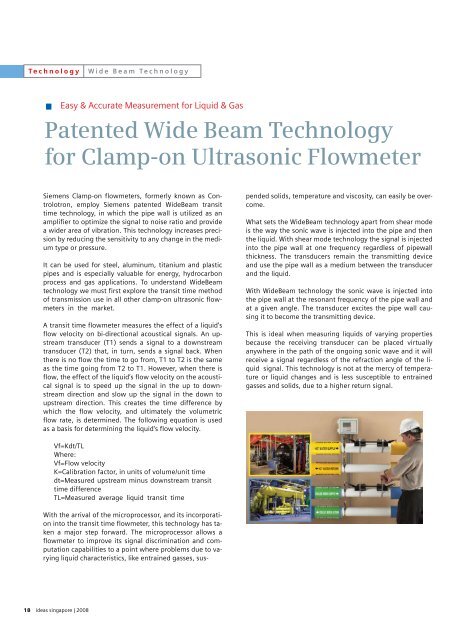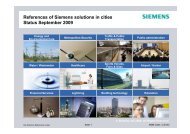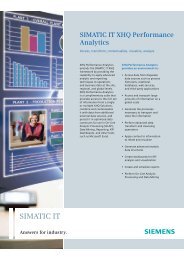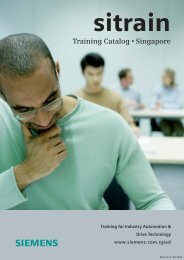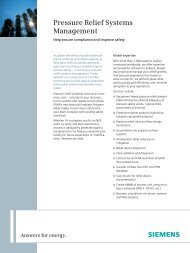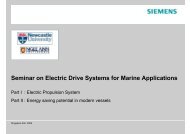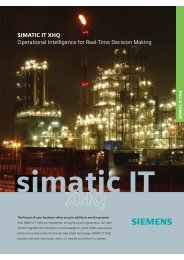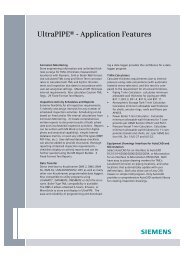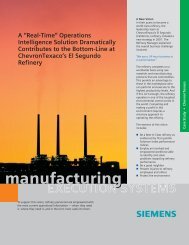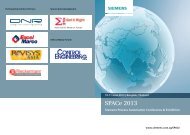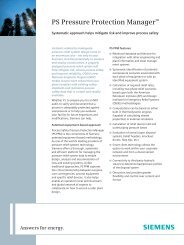Ideas - Siemens
Ideas - Siemens
Ideas - Siemens
You also want an ePaper? Increase the reach of your titles
YUMPU automatically turns print PDFs into web optimized ePapers that Google loves.
Technology<br />
Wide Beam Technology<br />
Easy & Accurate Measurement for Liquid & Gas<br />
Patented Wide Beam Technology<br />
for Clamp-on Ultrasonic Flowmeter<br />
<strong>Siemens</strong> Clamp-on flowmeters, formerly known as Controlotron,<br />
employ <strong>Siemens</strong> patented WideBeam transit<br />
time technology, in which the pipe wall is utilized as an<br />
amplifier to optimize the signal to noise ratio and provide<br />
a wider area of vibration. This technology increases precision<br />
by reducing the sensitivity to any change in the medium<br />
type or pressure.<br />
It can be used for steel, aluminum, titanium and plastic<br />
pipes and is especially valuable for energy, hydrocarbon<br />
process and gas applications. To understand WideBeam<br />
technology we must first explore the transit time method<br />
of transmission use in all other clamp-on ultrasonic flowmeters<br />
in the market. time and the Shear Mode approach...<br />
A transit time flowmeter measures the effect of a liquid’s<br />
flow velocity on bi-directional acoustical signals. An upstream<br />
transducer (T1) sends a signal to a downstream<br />
transducer (T2) that, in turn, sends a signal back. When<br />
there is no flow the time to go from, T1 to T2 is the same<br />
as the time going from T2 to T1. However, when there is<br />
flow, the effect of the liquid’s flow velocity on the acoustical<br />
signal is to speed up the signal in the up to downstream<br />
direction and slow up the signal in the down to<br />
upstream direction. This creates the time difference by<br />
which the flow velocity, and ultimately the volumetric<br />
flow rate, is determined. The following equation is used<br />
as a basis for determining the liquid‘s flow velocity.<br />
Vf=Kdt/TL<br />
Where:<br />
Vf=Flow velocity<br />
K=Calibration factor, in units of volume/unit time<br />
dt=Measured upstream minus downstream transit<br />
time difference<br />
TL=Measured average liquid transit timeWideBeam<br />
approach...<br />
With the arrival of the microprocessor, and its incorporation<br />
into the transit time flowmeter, this technology has taken<br />
a major step forward. The microprocessor allows a<br />
flowmeter to improve its signal discrimination and computation<br />
capabilities to a point where problems due to varying<br />
liquid characteristics, like entrained gasses, suspended<br />
solids, temperature and viscosity, can easily be overcome.<br />
What sets the WideBeam technology apart from shear mode<br />
is the way the sonic wave is injected into the pipe and then<br />
the liquid. With shear mode technology the signal is injected<br />
into the pipe wall at one frequency regardless of pipewall<br />
thickness. The transducers remain the transmitting device<br />
and use the pipe wall as a medium between the transducer<br />
and the liquid.<br />
With WideBeam technology the sonic wave is injected into<br />
the pipe wall at the resonant frequency of the pipe wall and<br />
at a given angle. The transducer excites the pipe wall causing<br />
it to become the transmitting device.<br />
This is ideal when measuring liquids of varying properties<br />
because the receiving transducer can be placed virtually<br />
anywhere in the path of the ongoing sonic wave and it will<br />
receive a signal regardless of the refraction angle of the liquid<br />
signal. This technology is not at the mercy of temperature<br />
or liquid changes and is less susceptible to entrained<br />
gasses and solids, due to a higher return signal.<br />
18 ideas singapore | 2008


